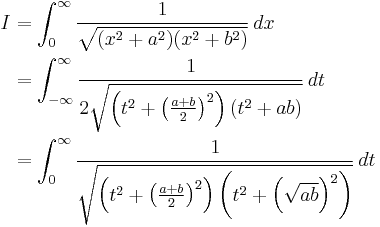Landen's transformation
Landen's transformation, independently rediscovered by Gauss, is a mapping of the parameters of an elliptic integral, which leaves the value of the integral unchanged.
In Gauss's formulation,
is unchanged if  and
and  are replaced by their arithmetic and geometric means respectively, that is
are replaced by their arithmetic and geometric means respectively, that is
Proof
The transformation, may be achieved purely by integration by substitution. It is convenient to first cast the integral in an algebraic form by a substitution of  ,
,  giving
giving
A further substitution of  gives the desired result (in the algebraic form)
gives the desired result (in the algebraic form)
This latter step is facilitated by writing the radical as
and the infinitesimal as
so that the factor of  is easily recognized and cancelled between the two factors.
is easily recognized and cancelled between the two factors.
Arithmetic-geometric mean and Legendre's first integral
If the transformation is iterated a number of times, then the parameters  and
and  converge very rapidly to a common value, even if they are initially of different orders of magnitude. The limiting value is called the arithmetic-geometric mean of
converge very rapidly to a common value, even if they are initially of different orders of magnitude. The limiting value is called the arithmetic-geometric mean of  and
and  ,
,  . In the limit, the integrand becomes a constant, so that integration is trivial
. In the limit, the integrand becomes a constant, so that integration is trivial
The integral may also be recognized as a multiple of Legendre's complete elliptic integral of the first kind. Putting 
Hence, for any  , the arithmetic-geometric mean and the complete elliptic integral of the first kind are related by
, the arithmetic-geometric mean and the complete elliptic integral of the first kind are related by
By performing an inverse transformation (reverse arithmetic-geometric mean iteration), that is
the relationship may be written as
which may be solved for the AGM of a pair of arbitrary arguments;
- The definition adopted here for
 , differs from that used in the arithmetic-geometric mean article, such that
, differs from that used in the arithmetic-geometric mean article, such that  here is
here is  in that article.
in that article.
References
- Louis V. King On The Direct Numerical Calculation Of Elliptic Functions And Integrals (Cambridge University Press, 1924)













